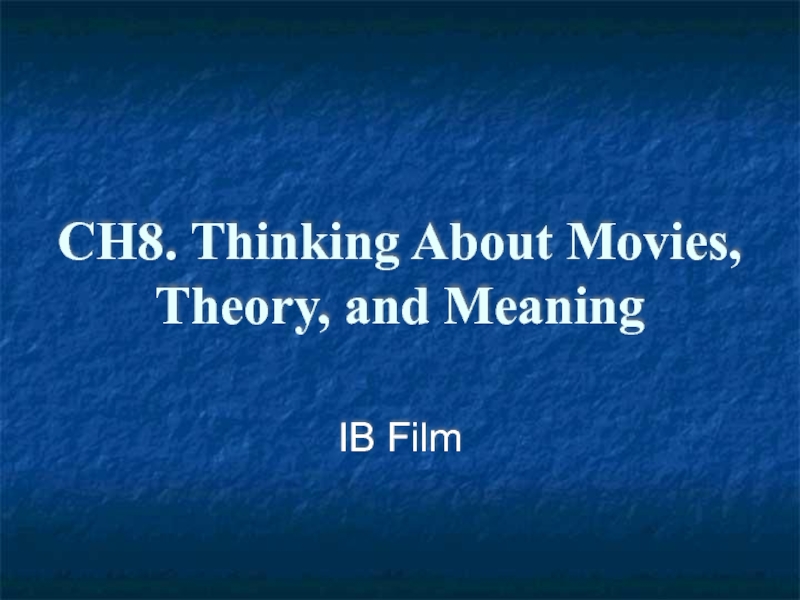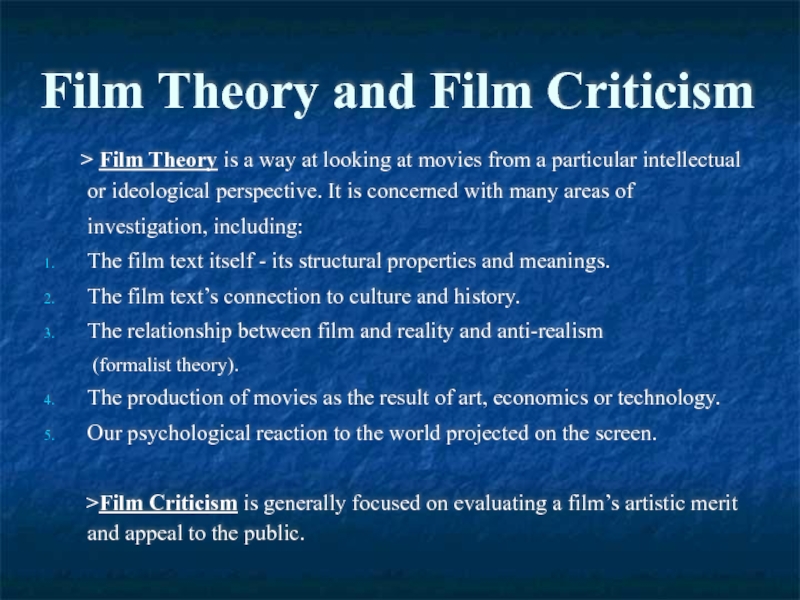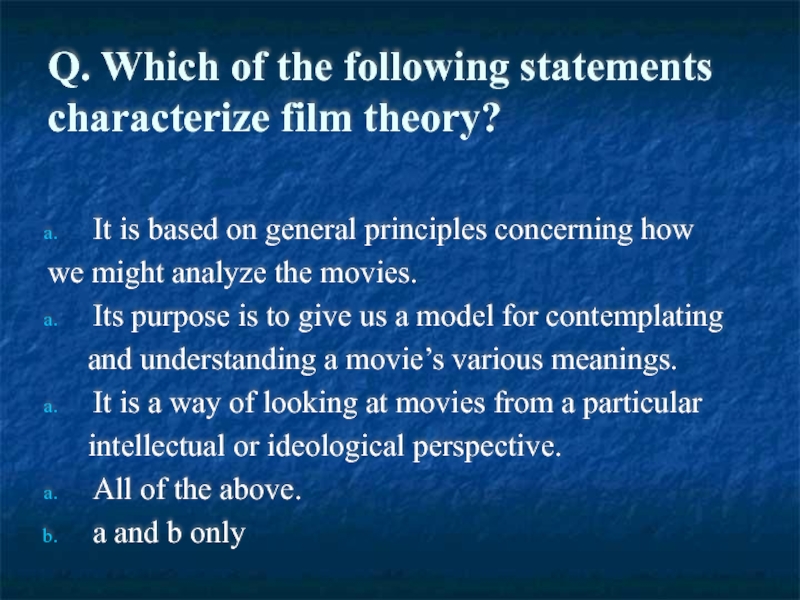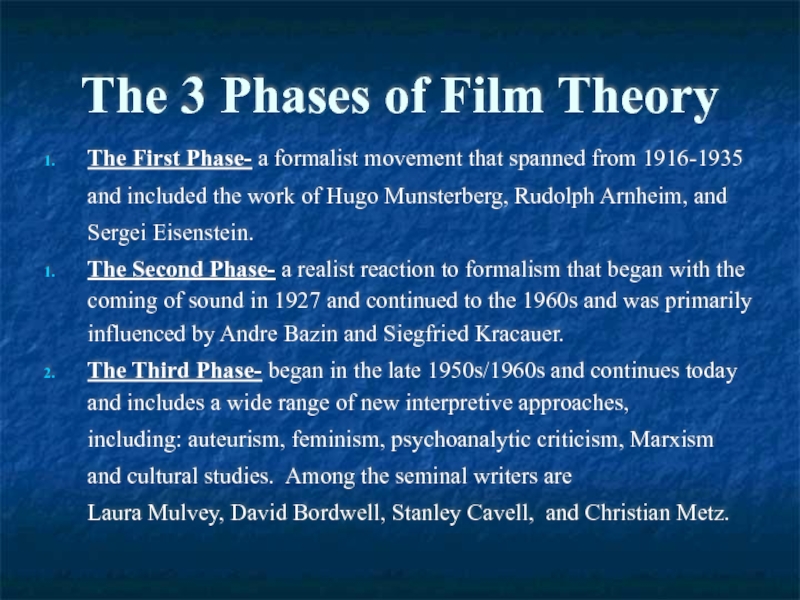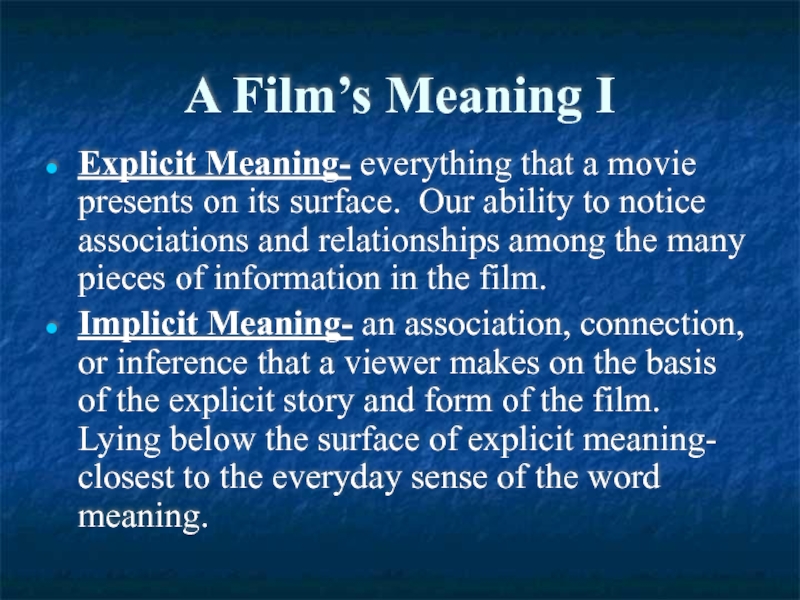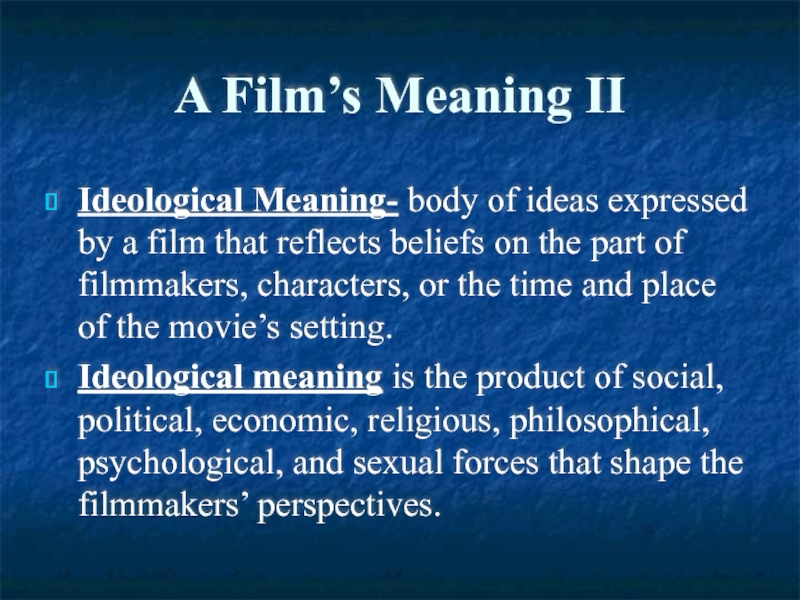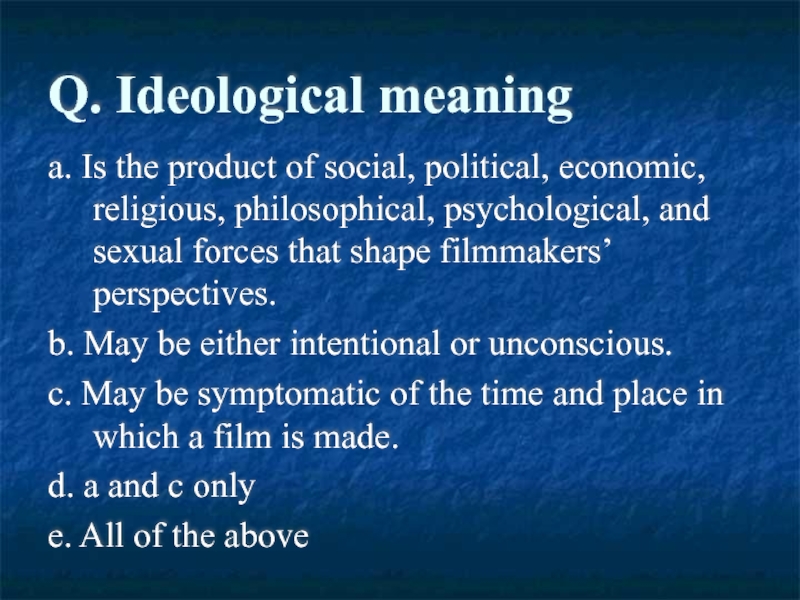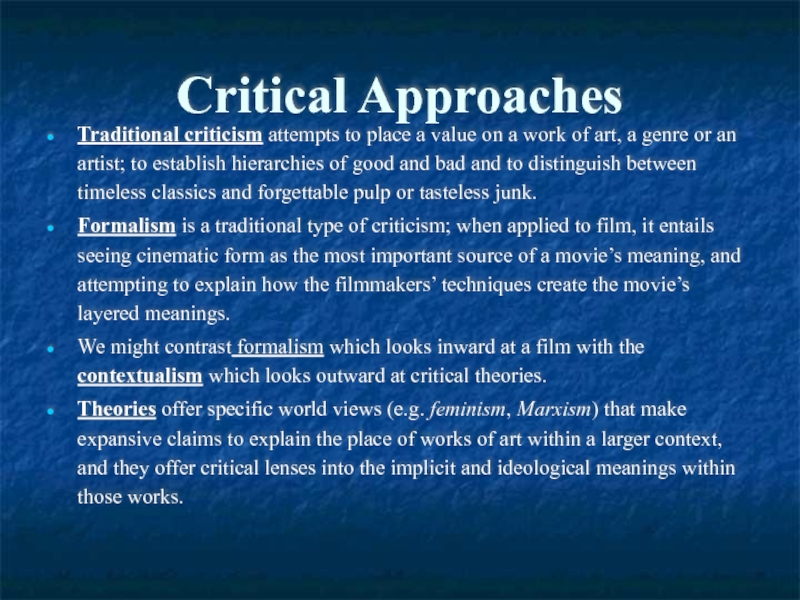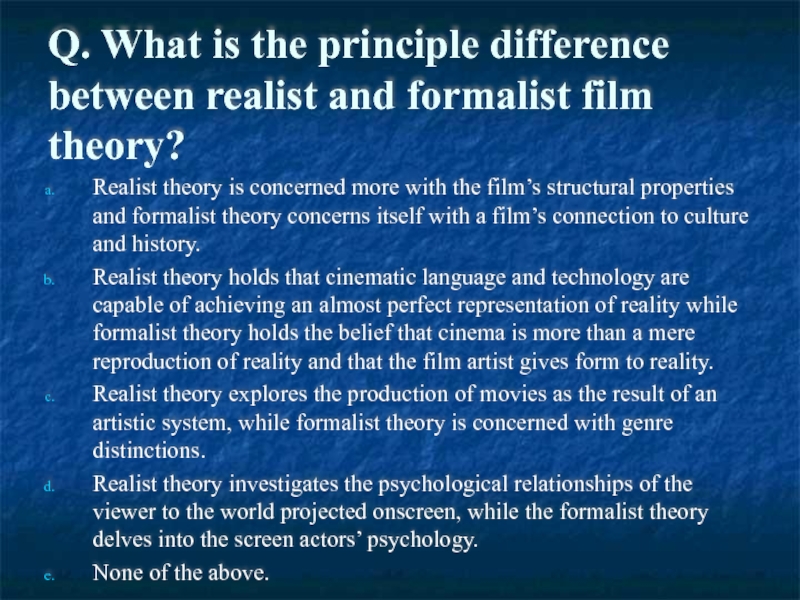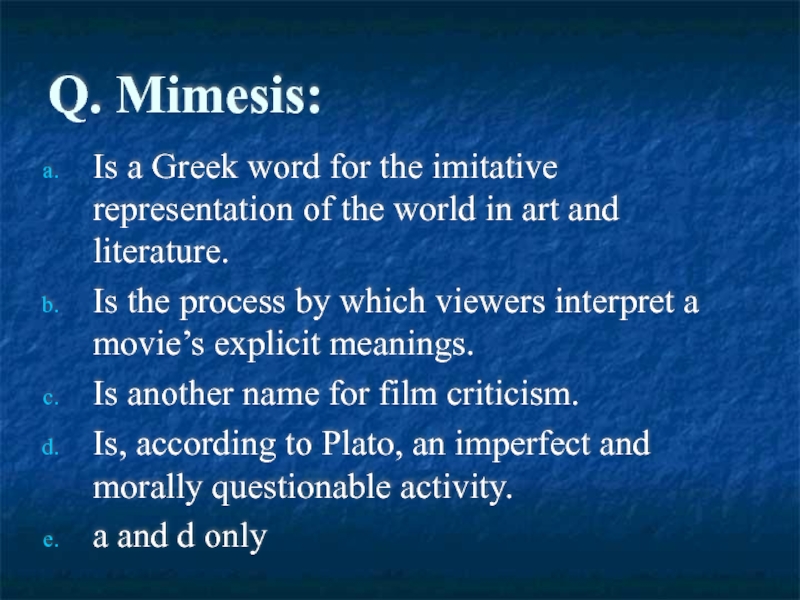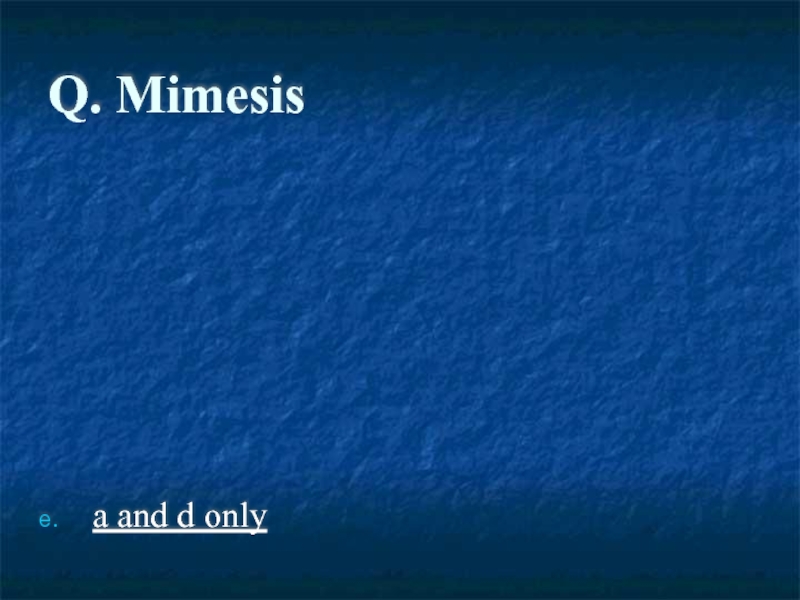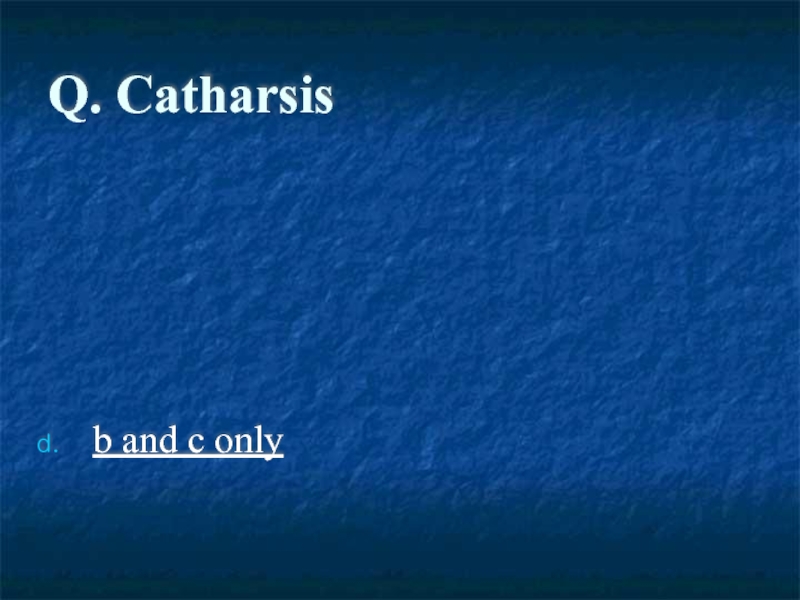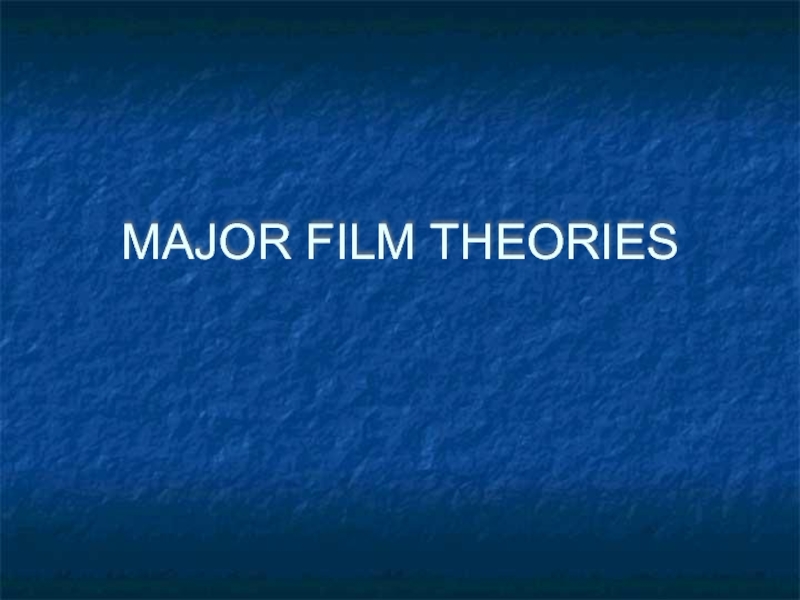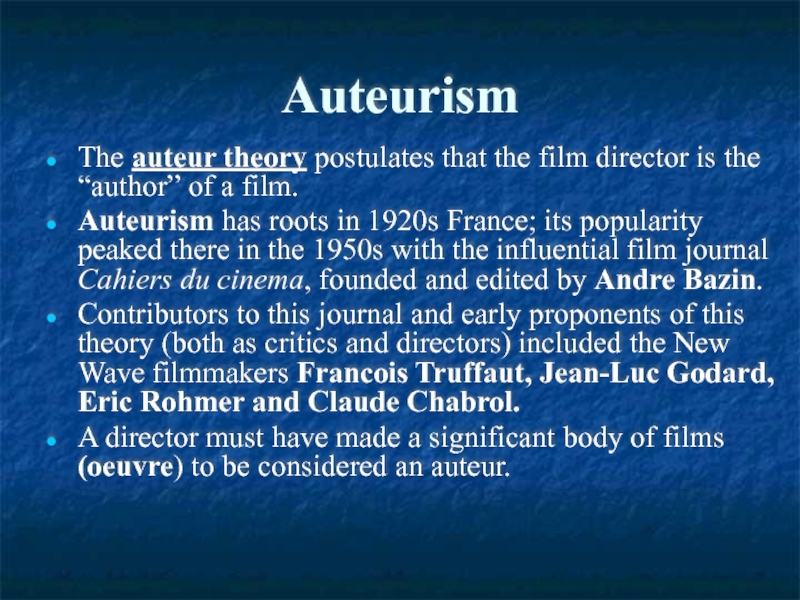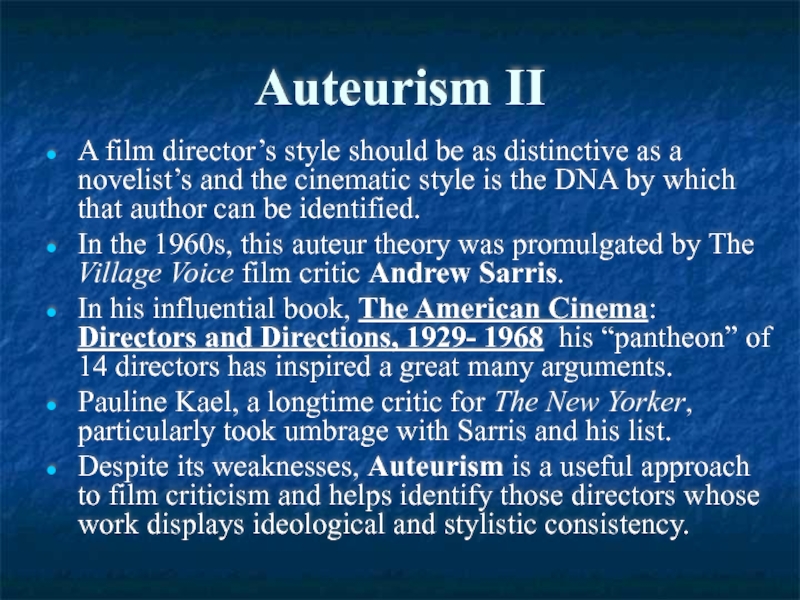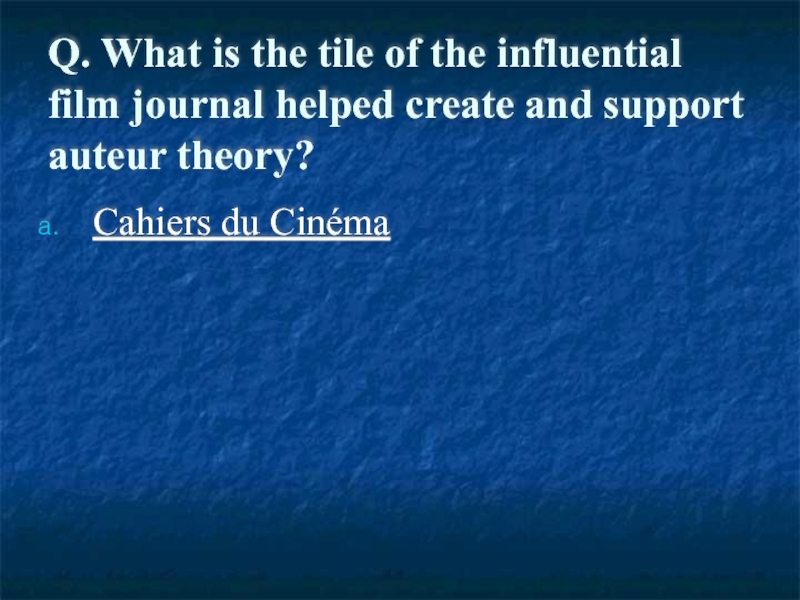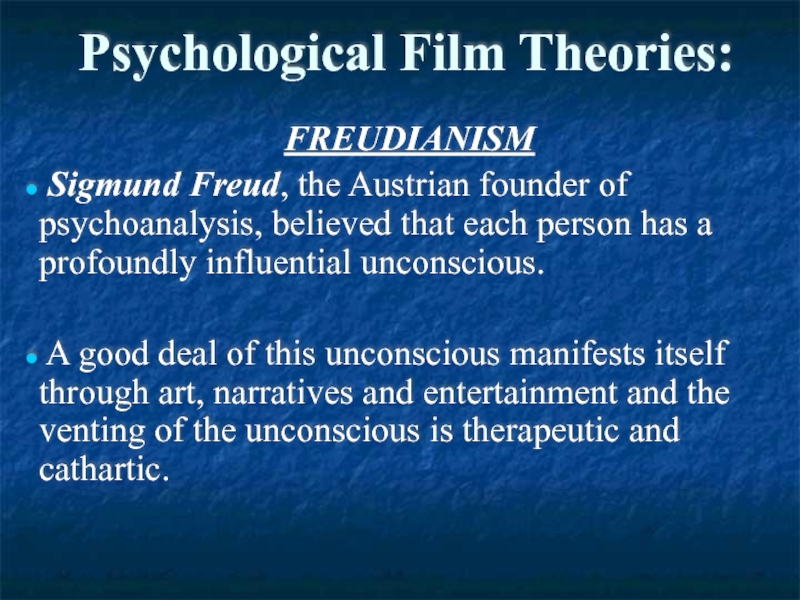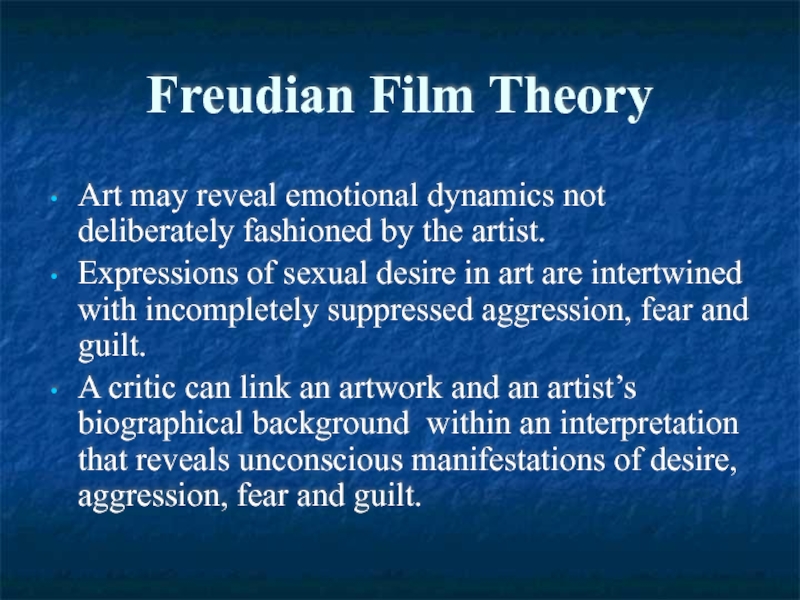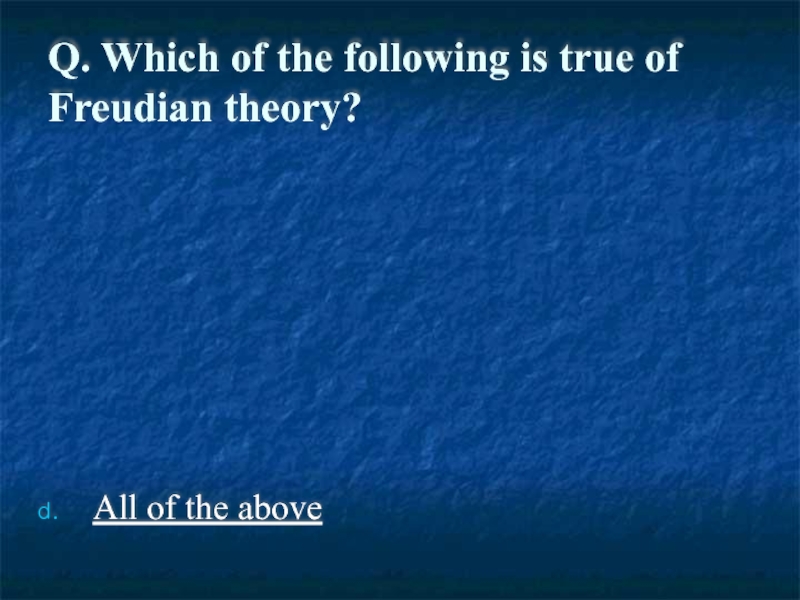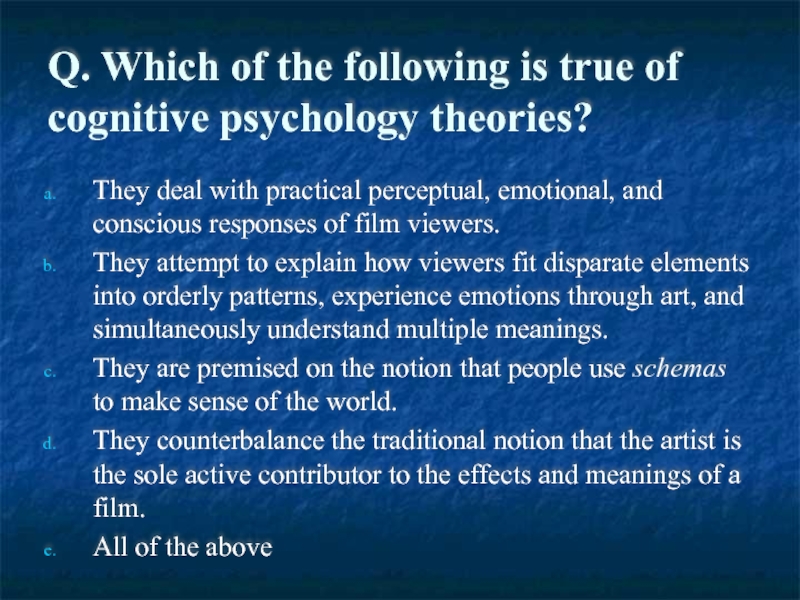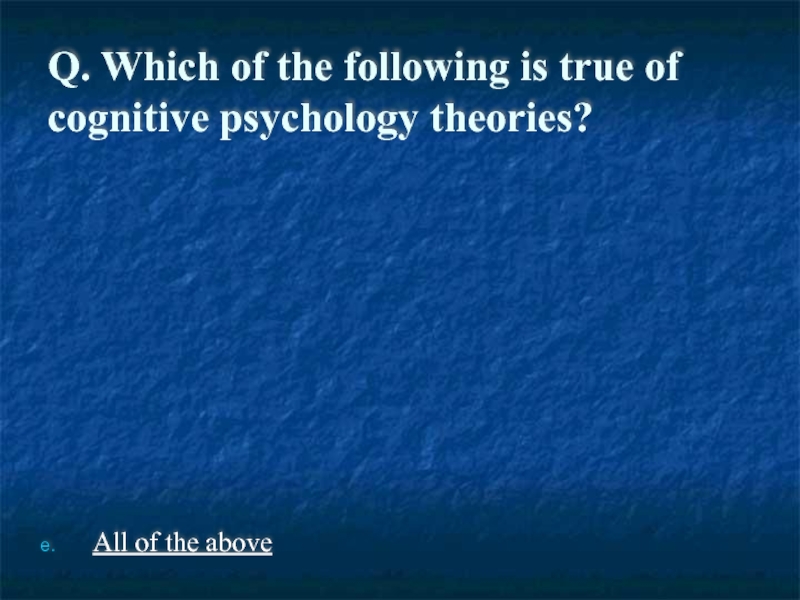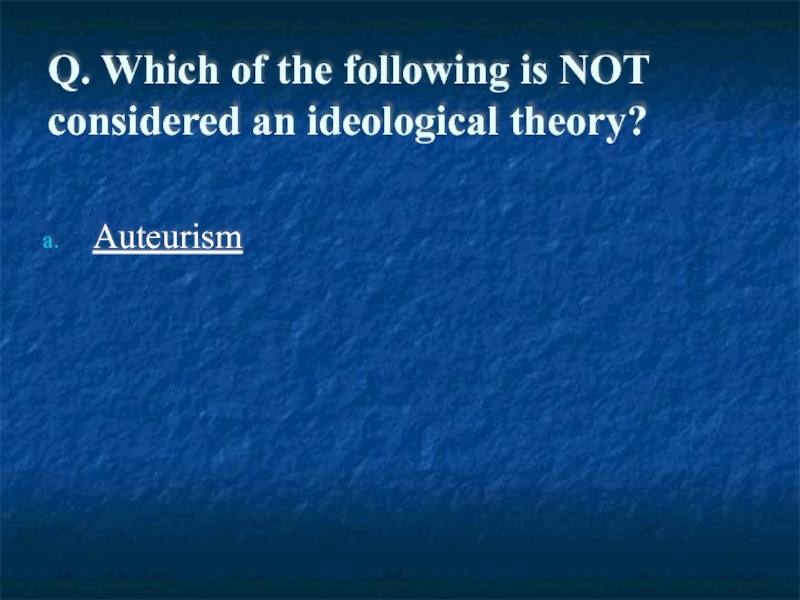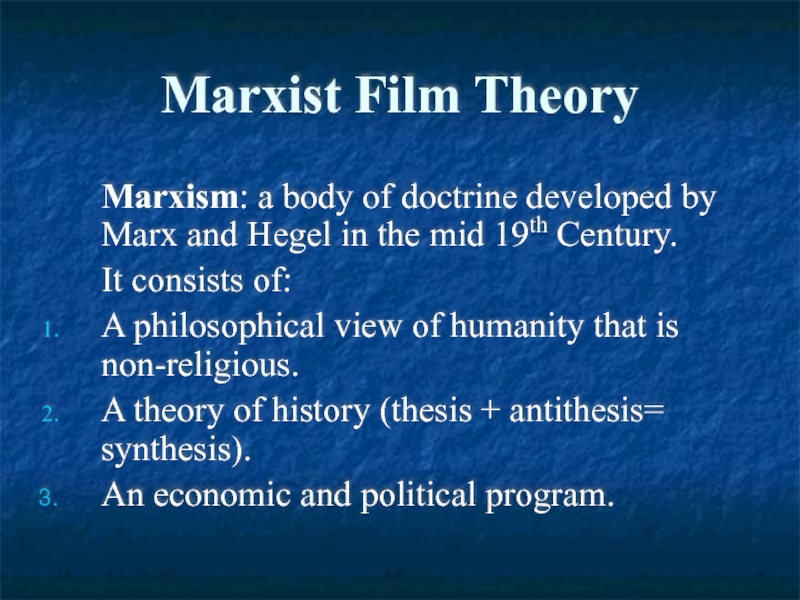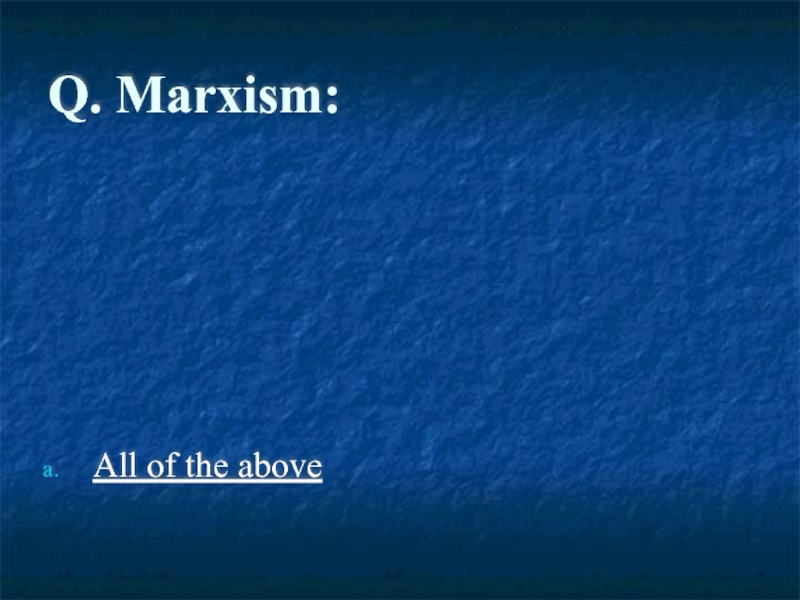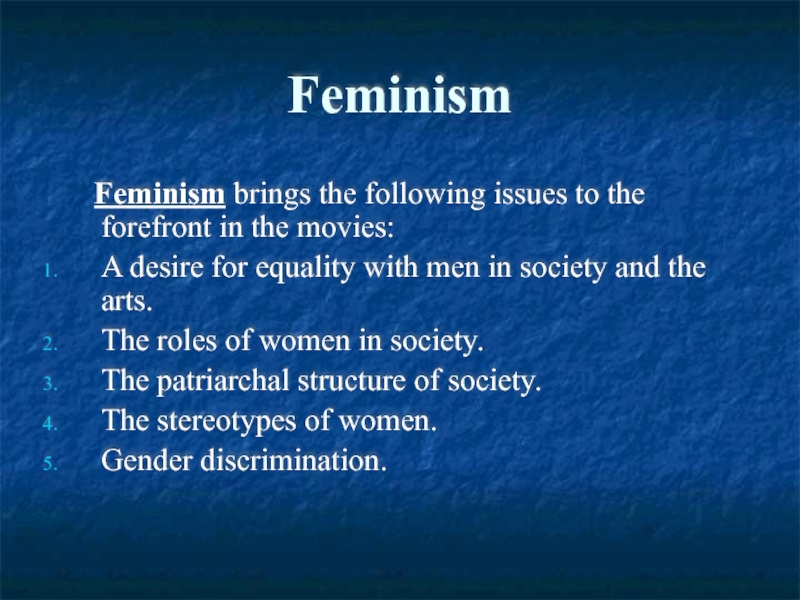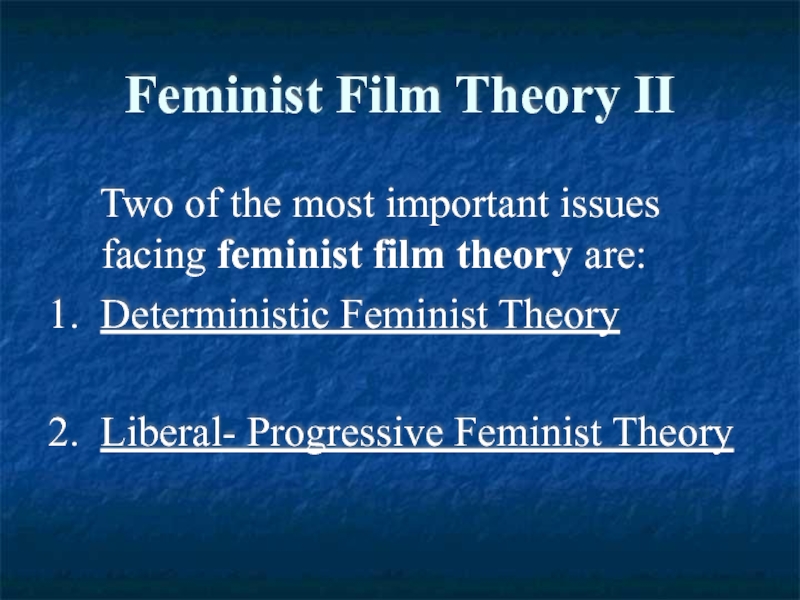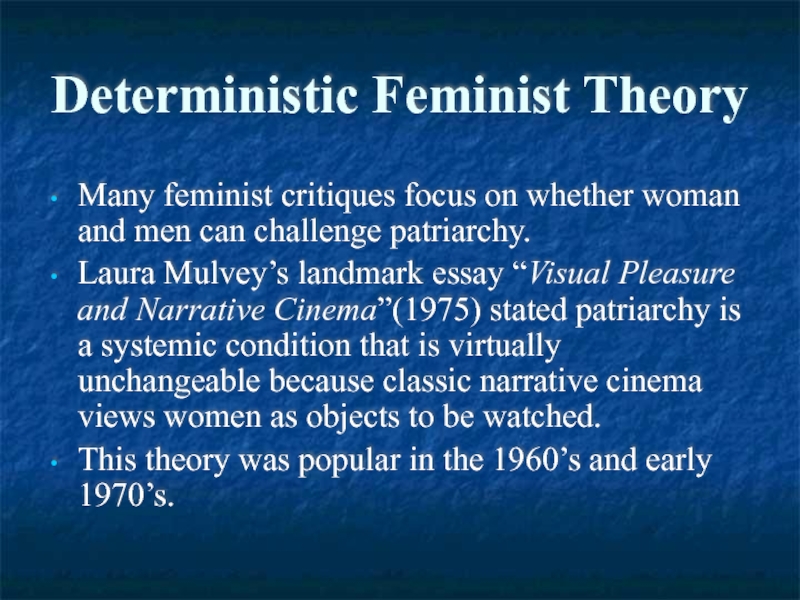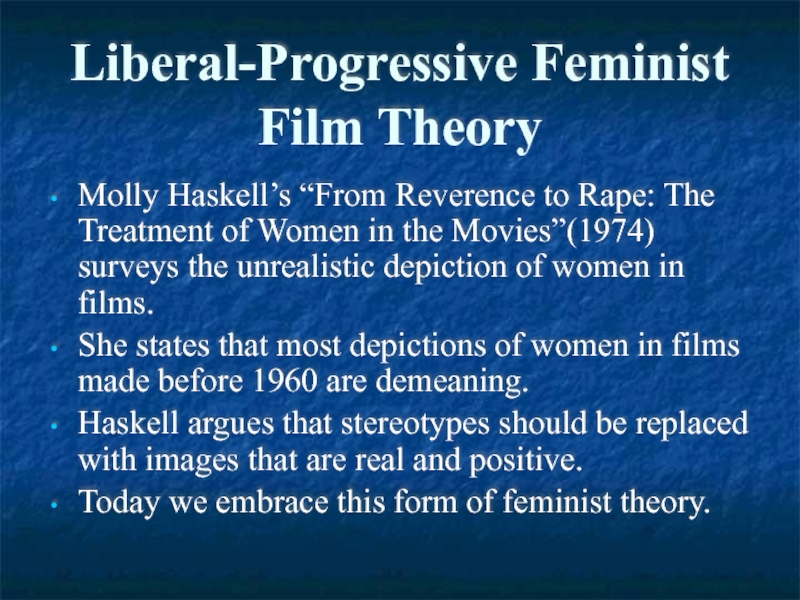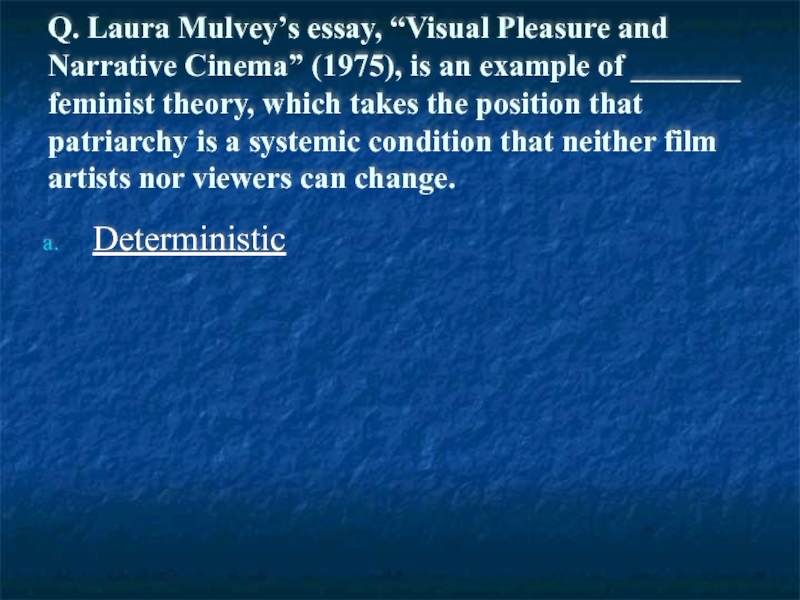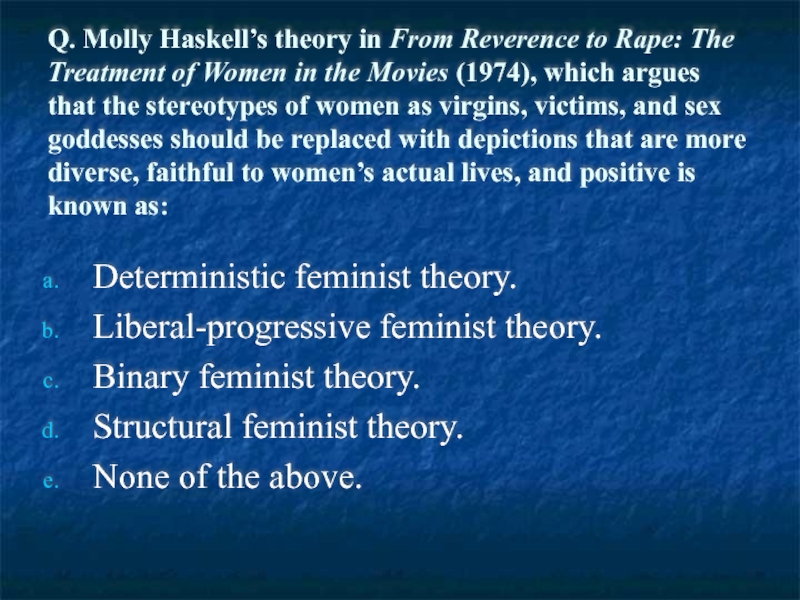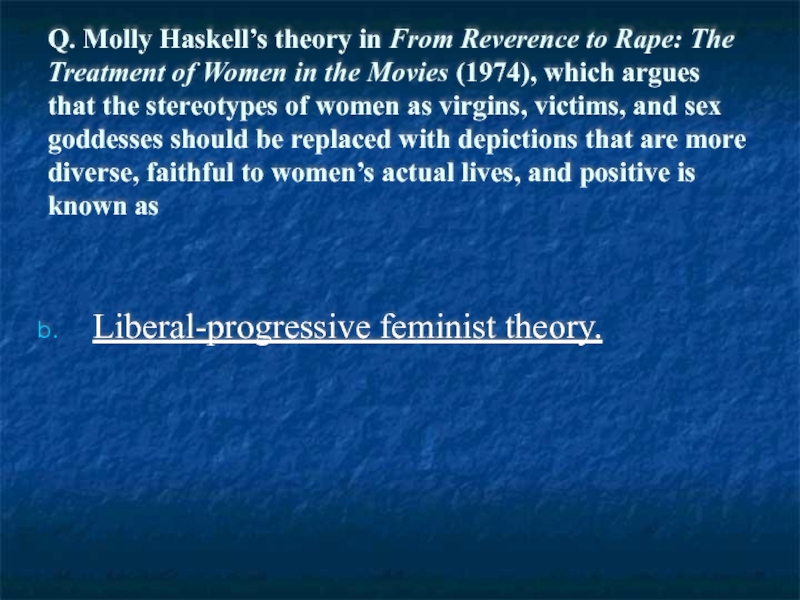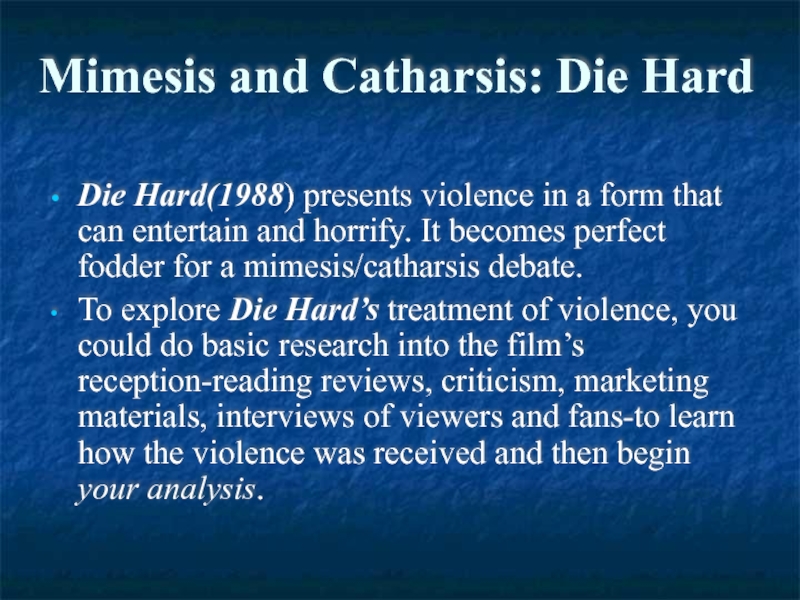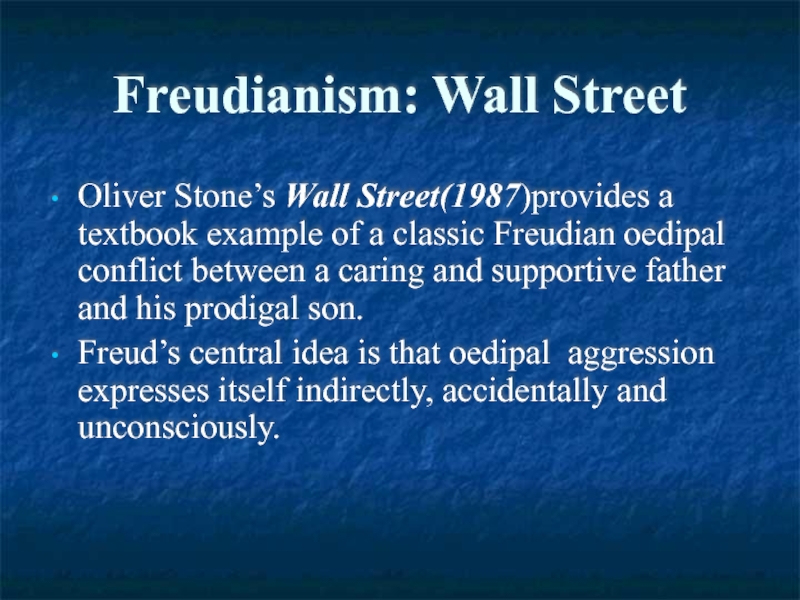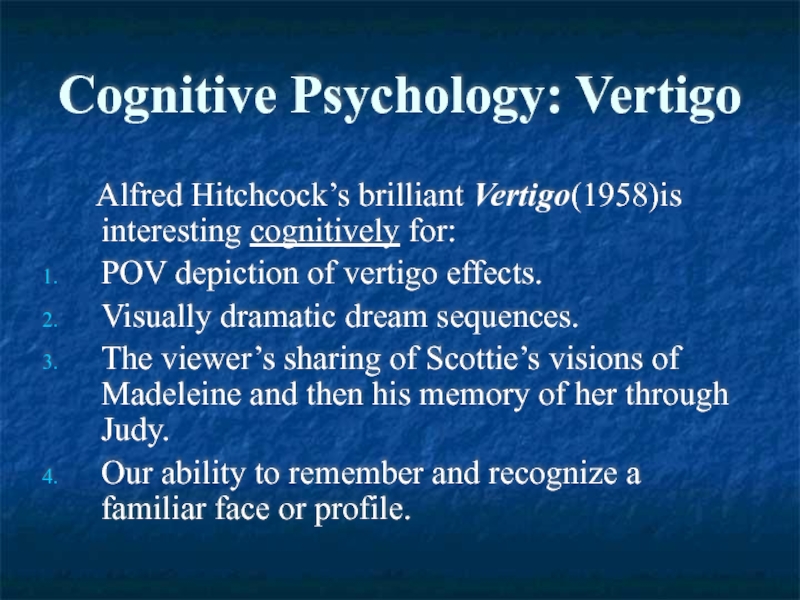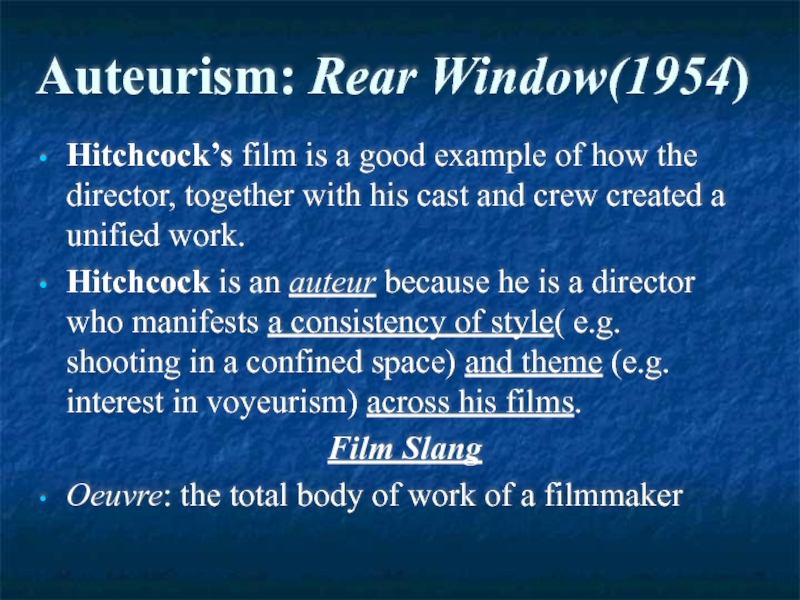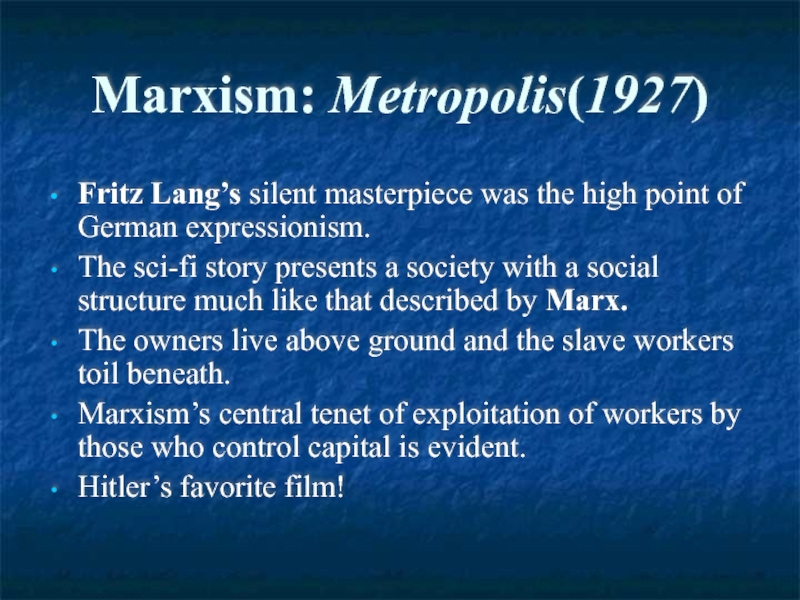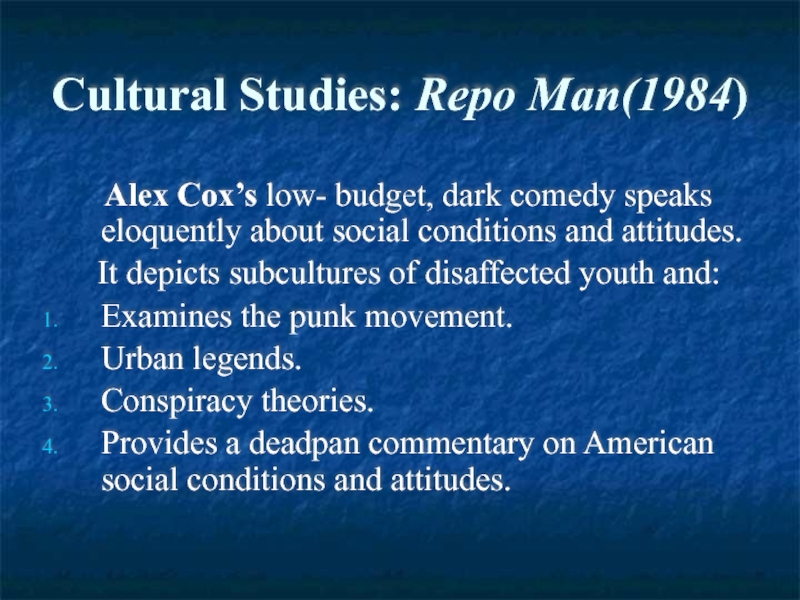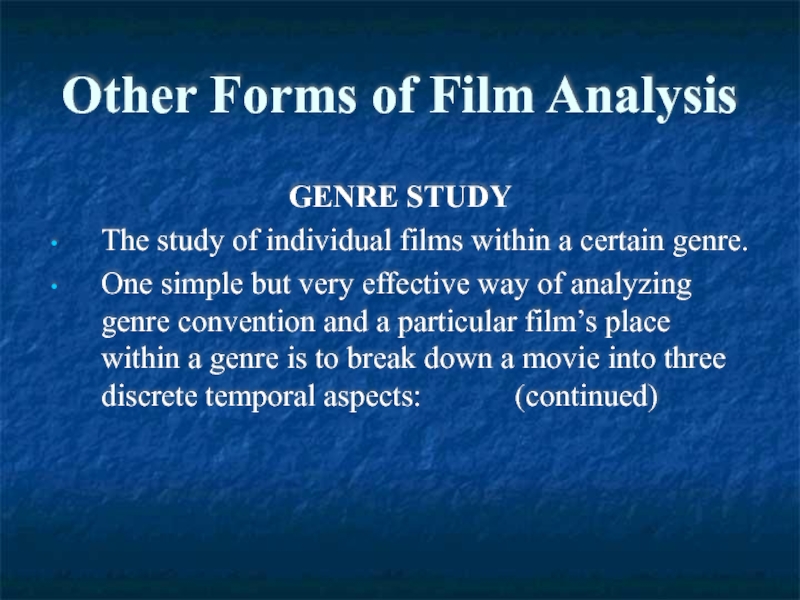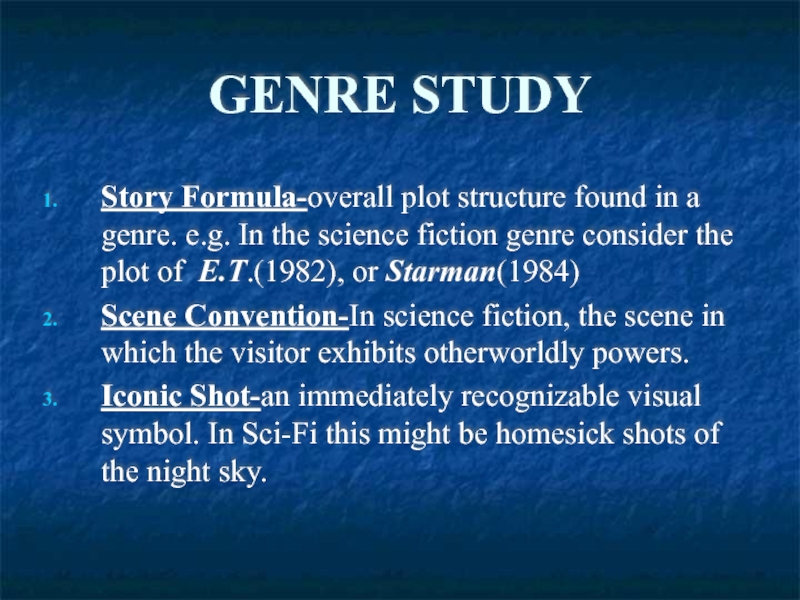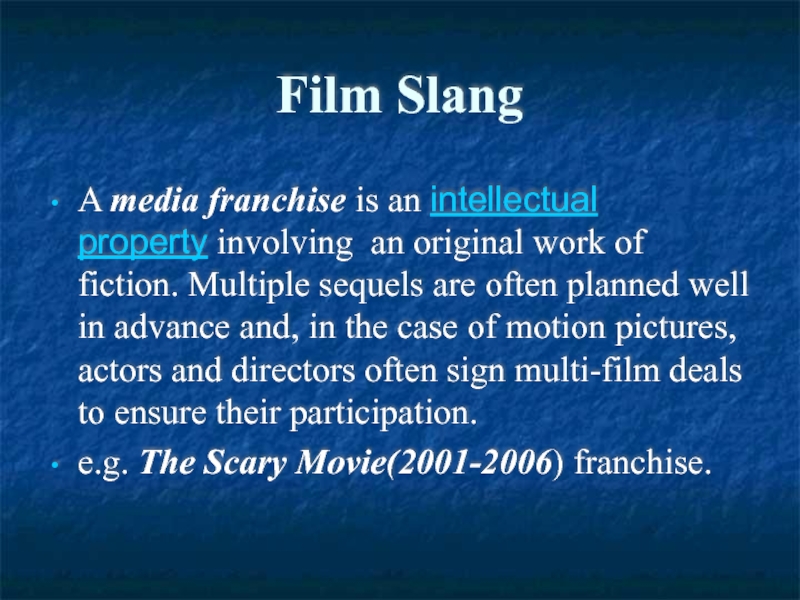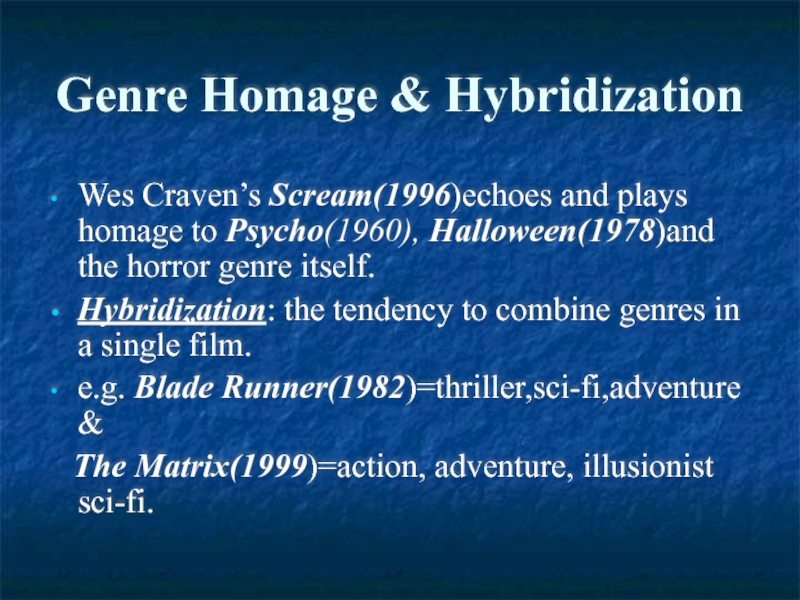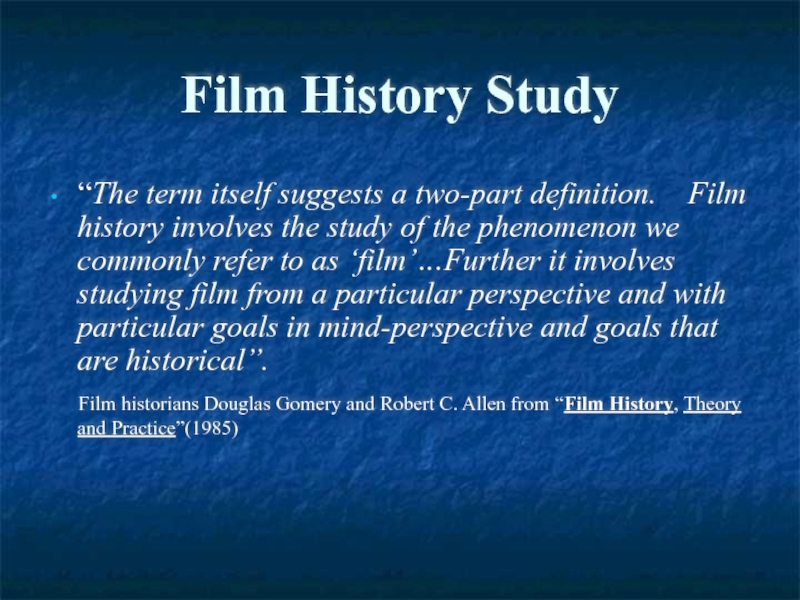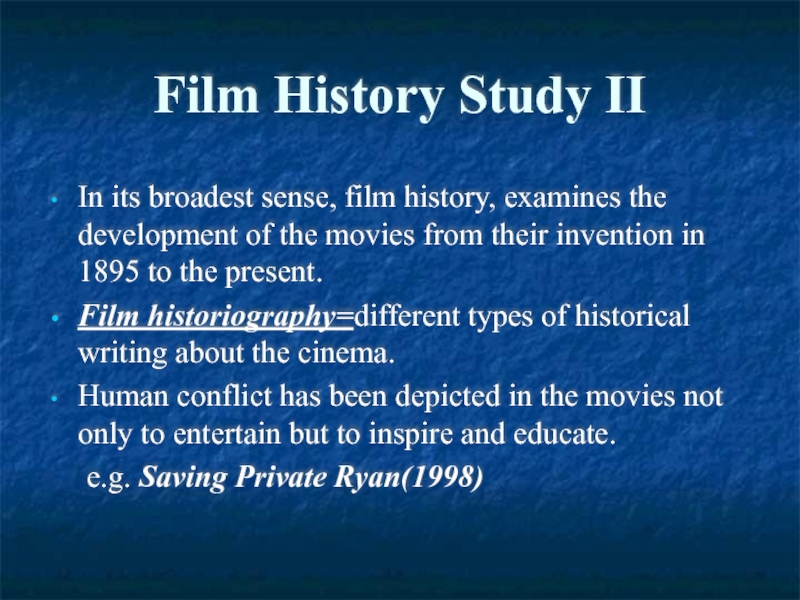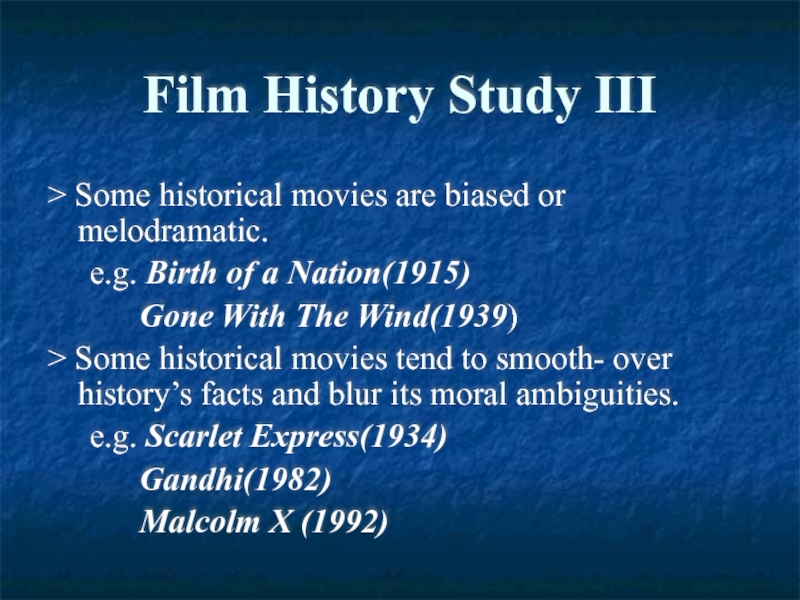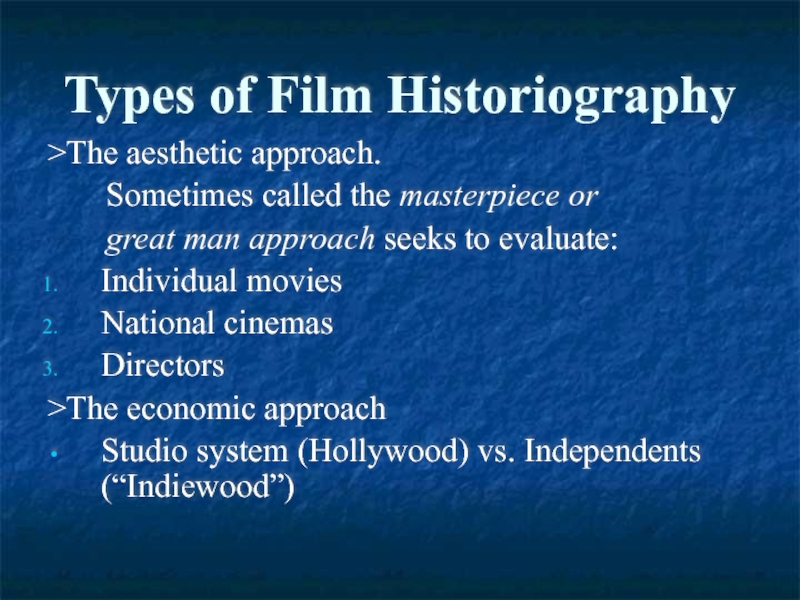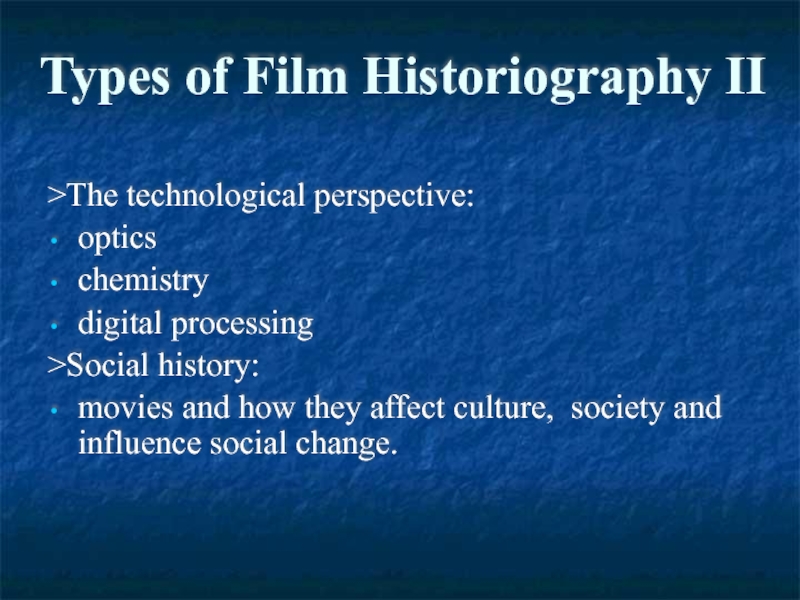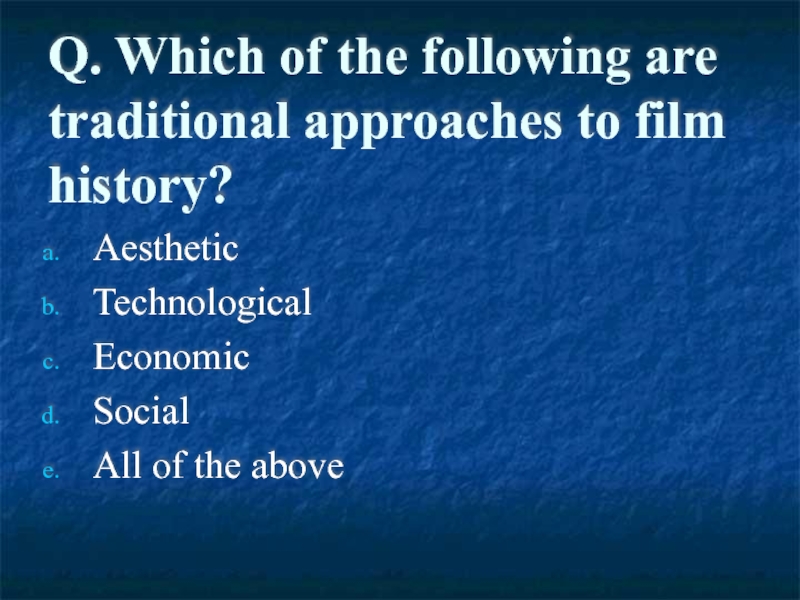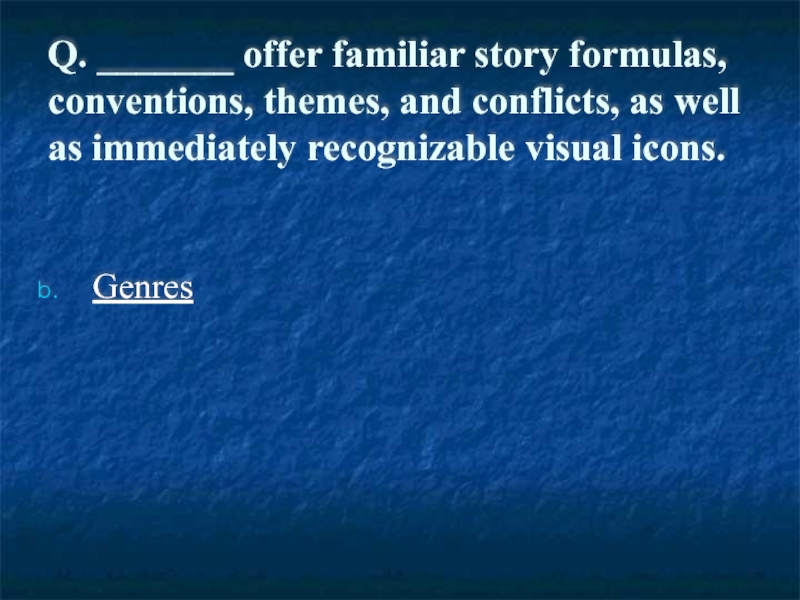- Главная
- Разное
- Дизайн
- Бизнес и предпринимательство
- Аналитика
- Образование
- Развлечения
- Красота и здоровье
- Финансы
- Государство
- Путешествия
- Спорт
- Недвижимость
- Армия
- Графика
- Культурология
- Еда и кулинария
- Лингвистика
- Английский язык
- Астрономия
- Алгебра
- Биология
- География
- Детские презентации
- Информатика
- История
- Литература
- Маркетинг
- Математика
- Медицина
- Менеджмент
- Музыка
- МХК
- Немецкий язык
- ОБЖ
- Обществознание
- Окружающий мир
- Педагогика
- Русский язык
- Технология
- Физика
- Философия
- Химия
- Шаблоны, картинки для презентаций
- Экология
- Экономика
- Юриспруденция
Thinking about movies, theory, and meaning презентация
Содержание
- 1. Thinking about movies, theory, and meaning
- 2. Movies and Meaning Movies can mean a
- 3. Film Theory and Film Criticism
- 4. Q. Which of the following statements
- 5. The 3 Phases of Film Theory The
- 6. A Film’s Meaning I Explicit Meaning- everything
- 7. A Film’s Meaning II Ideological Meaning- body
- 8. Q. Ideological meaning a. Is the product
- 9. Q. Ideological meaning All of the above
- 10. Critical Approaches Traditional criticism attempts to place
- 11. Q. What is the principle difference between
- 12. Q. What is the principle difference between
- 13. Interpretive Frameworks
- 14. Mimesis and Catharsis Mimesis and Catharsis: In
- 15. Q. Mimesis: Is a Greek word for
- 16. Q. Mimesis a and d only
- 17. Q. Catharsis: Is a Latin word meaning
- 18. Q. Catharsis b and c only
- 19. Binary Oppositions(Dualism) According to structuralist anthropologist Claude
- 20. MAJOR FILM THEORIES
- 21. Auteurism
- 22. Auteurism II
- 23. Q. What is the title of the
- 24. Q. What is the tile of the
- 25. Psychological Film Theories: FREUDIANISM Sigmund Freud,
- 26. Films with Notable Freudian Influence Ingmar Bergman’s
- 27. Freudian Film Theory Art may reveal emotional
- 28. Q. Which of the following is true
- 29. Q. Which of the following is true
- 30. Psychological Theories: Cognitive Psychology Draws
- 31. Cognitive Psychology II A foundational idea of
- 32. Q. Which of the following is true
- 33. Q. Which of the following is true
- 34. Ideological Theory-An Overview Ideological criticism attends to
- 35. Q. Which of the following is NOT
- 36. Q. Which of the following is NOT considered an ideological theory? Auteurism
- 37. Marxist Film Theory Marxism:
- 38. Marxist Film Theory II The idea of
- 39. Q. Marxism: Is a system of thought
- 40. Q. Marxism: All of the above
- 41. Feminism Feminism brings the
- 42. Feminist Film Theory Feminist
- 43. Feminist Film Theory II
- 44. Deterministic Feminist Theory Many feminist critiques focus
- 45. Liberal-Progressive Feminist Film Theory Molly Haskell’s “From
- 46. Q. Laura Mulvey’s essay, “Visual Pleasure and
- 47. Q. Laura Mulvey’s essay, “Visual Pleasure and
- 48. Q. Molly Haskell’s theory in From Reverence
- 49. Q. Molly Haskell’s theory in From Reverence
- 50. Cultural Studies In the 1920’s The Frankfurt
- 51. APPLIED READINGS
- 52. Applied Readings Let’s now look at a
- 53. Mimesis and Catharsis: Die Hard Die Hard(1988)
- 54. Binary Oppositions: Die Hard Compose a
- 55. Freudianism: Wall Street Oliver Stone’s Wall Street(1987)provides
- 56. Cognitive Psychology: Vertigo Alfred
- 57. Auteurism: Rear Window(1954) Hitchcock’s film is a
- 58. Marxism: Metropolis(1927) Fritz Lang’s silent masterpiece was
- 59. Feminism: Thelma and Louise(1991)
- 60. Feminism: Thelma and Louise II 3.Thelma and
- 61. Cultural Studies: Repo Man(1984)
- 62. Buzz Words Cult: any cause, person or
- 63. Other Forms of Film Analysis GENRE STUDY
- 64. GENRE STUDY Story Formula-overall plot structure found
- 65. Q. _______ is the overall plot structure
- 66. Q. _______ is the overall plot structure found in a genre. Story formula
- 67. Film Slang A media franchise is an intellectual
- 68. Genre Homage & Hybridization Wes Craven’s Scream(1996)echoes
- 69. Film History Study “The term itself suggests
- 70. Film History Study II In its broadest
- 71. Film History Study III > Some historical
- 72. Types of Film Historiography >The aesthetic approach.
- 73. Types of Film Historiography II >The technological
- 74. Q. Which of the following are traditional
- 75. Q. Which of the following are traditional
- 76. Q. _______ offer familiar story formulas, conventions,
- 77. Q. _______ offer familiar story formulas, conventions,
- 78. Q. The chapter discuss three interpretive frameworks,
- 79. Q. The chapter discuss three interpretive frameworks,
- 80. THANK YOU!
Слайд 2Movies and Meaning
Movies can mean a great number of things, and
Question to ask yourself:
Why has a movie stimulated my
intellectual or
emotional responses?
In IB Film we always want to go beyond “I loved, liked or hated
it” to find convincing reasons within the movie to support our
opinions.
In this next unit, we are going to examine and apply the many
different theoretical and critical models that allow us to enrich
our film viewing experience and improve our ability to offer an
intelligent and provocative analysis of the films we see.
Слайд 3Film Theory and Film Criticism
> Film Theory is
investigation, including:
The film text itself - its structural properties and meanings.
The film text’s connection to culture and history.
The relationship between film and reality and anti-realism
(formalist theory).
The production of movies as the result of art, economics or technology.
Our psychological reaction to the world projected on the screen.
>Film Criticism is generally focused on evaluating a film’s artistic merit and appeal to the public.
Слайд 4Q. Which of the following statements
characterize film theory?
It is based
we might analyze the movies.
Its purpose is to give us a model for contemplating
and understanding a movie’s various meanings.
It is a way of looking at movies from a particular
intellectual or ideological perspective.
All of the above.
a and b only
Слайд 5The 3 Phases of Film Theory
The First Phase- a formalist movement
and included the work of Hugo Munsterberg, Rudolph Arnheim, and
Sergei Eisenstein.
The Second Phase- a realist reaction to formalism that began with the coming of sound in 1927 and continued to the 1960s and was primarily influenced by Andre Bazin and Siegfried Kracauer.
The Third Phase- began in the late 1950s/1960s and continues today and includes a wide range of new interpretive approaches,
including: auteurism, feminism, psychoanalytic criticism, Marxism
and cultural studies. Among the seminal writers are
Laura Mulvey, David Bordwell, Stanley Cavell, and Christian Metz.
Слайд 6A Film’s Meaning I
Explicit Meaning- everything that a movie presents on
Implicit Meaning- an association, connection, or inference that a viewer makes on the basis of the explicit story and form of the film. Lying below the surface of explicit meaning- closest to the everyday sense of the word meaning.
Слайд 7A Film’s Meaning II
Ideological Meaning- body of ideas expressed by a
Ideological meaning is the product of social, political, economic, religious, philosophical, psychological, and sexual forces that shape the filmmakers’ perspectives.
Слайд 8Q. Ideological meaning
a. Is the product of social, political, economic, religious,
b. May be either intentional or unconscious.
c. May be symptomatic of the time and place in which a film is made.
d. a and c only
e. All of the above
Слайд 10Critical Approaches
Traditional criticism attempts to place a value on a work
Formalism is a traditional type of criticism; when applied to film, it entails seeing cinematic form as the most important source of a movie’s meaning, and attempting to explain how the filmmakers’ techniques create the movie’s layered meanings.
We might contrast formalism which looks inward at a film with the contextualism which looks outward at critical theories.
Theories offer specific world views (e.g. feminism, Marxism) that make expansive claims to explain the place of works of art within a larger context, and they offer critical lenses into the implicit and ideological meanings within those works.
Слайд 11Q. What is the principle difference between realist and formalist film
Realist theory is concerned more with the film’s structural properties and formalist theory concerns itself with a film’s connection to culture and history.
Realist theory holds that cinematic language and technology are capable of achieving an almost perfect representation of reality while formalist theory holds the belief that cinema is more than a mere reproduction of reality and that the film artist gives form to reality.
Realist theory explores the production of movies as the result of an artistic system, while formalist theory is concerned with genre distinctions.
Realist theory investigates the psychological relationships of the viewer to the world projected onscreen, while the formalist theory delves into the screen actors’ psychology.
None of the above.
Слайд 12Q. What is the principle difference between realist and formalist film
Realist theory holds that cinematic language and technology are capable of achieving an almost perfect representation of reality while formalist theory holds the belief that cinema is more than a mere reproduction of reality and that the film artist gives form to reality.
Слайд 14Mimesis and Catharsis
Mimesis and Catharsis: In the Western tradition, the effect
Plato opposed the idea of mimesis, the Greek word for the imitative representation of the world in art and literature.
On the other side of the Greek debate were the defenders of art. In the Poetics, Aristotle argued that humans acquire knowledge through imitation. More famously, he used the term catharsis-to describe a therapeutic by-product of watching tragedy, which, through fear and pity, purged viewers of such emotions.
e.g. In film studies, genres like horror, b-moves, pornography and violent films like Oliver Stone’s Natural Born Killers (1994) or Mel Gibson’s The Passion of the Christ (2004) generate complex issues in discussions about film violence.
Слайд 15Q. Mimesis:
Is a Greek word for the imitative representation of the
Is the process by which viewers interpret a movie’s explicit meanings.
Is another name for film criticism.
Is, according to Plato, an imperfect and morally questionable activity.
a and d only
Слайд 17Q. Catharsis:
Is a Latin word meaning “to run away.”
Is the name
Is frequently invoked to defend art that contains negative content (such as violence, criminality, or hatred)
b and c only
a, b, and c
Слайд 19Binary Oppositions(Dualism)
According to structuralist anthropologist Claude Levi- Strauss (b. 1908), all
In addition, each binary opposition reveals an underlying tension, a potential conflict that myth or art tries to reconcile. The form of such resolutions reflect the prevailing culture.
e.g. In James Cameron’s Terminator films we see the machines vs. humanity. In Terminator 2 (1991) the T-800=“human” and T-1000=“machine”. In Wizard of Oz (1939) It’s A Wonderful Life (1946) we see rural vs. urban and (“There’s no place like home”).
Dramatic conflict, in and of itself, creates binary oppositions.
Слайд 21Auteurism
The auteur theory postulates that the film director is the “author” of a film.
Auteurism has roots in 1920s France; its popularity peaked there in the 1950s with the influential film journal Cahiers du cinema, founded and edited by Andre Bazin.
Contributors to this journal and early proponents of this theory (both as critics and directors) included the New Wave filmmakers Francois Truffaut, Jean-Luc Godard, Eric Rohmer and Claude Chabrol.
A director must have made a significant body of films (oeuvre) to be considered an auteur.
Слайд 22Auteurism II
A film director’s style should be as distinctive as a novelist’s and the cinematic style is the DNA by which that author can be identified.
In the 1960s, this auteur theory was promulgated by The Village Voice film critic Andrew Sarris.
In his influential book, The American Cinema: Directors and Directions, 1929- 1968 his “pantheon” of 14 directors has inspired a great many arguments.
Pauline Kael, a longtime critic for The New Yorker, particularly took umbrage with Sarris and his list.
Despite its weaknesses, Auteurism is a useful approach to film criticism and helps identify those directors whose work displays ideological and stylistic consistency.
Слайд 23Q. What is the title of the influential film journal helped
Cahiers du Cinéma
The Village Voice
The New York Times
Camera Obscura
Wide angle
Слайд 24Q. What is the tile of the influential film journal helped
Cahiers du Cinéma
Слайд 25Psychological Film Theories:
FREUDIANISM
Sigmund Freud, the Austrian founder of psychoanalysis, believed
A good deal of this unconscious manifests itself through art, narratives and entertainment and the venting of the unconscious is therapeutic and cathartic.
Слайд 26Films with Notable Freudian Influence
Ingmar Bergman’s Fanny & Alexander(1982)
Alfred Hitchcock’s Spellbound(1945)
Jacques Tourneur’s Cat People(1942)
Fred Wilcox’s Forbidden Planet(1956)
Ken Russell’s Altered States(1980)
Слайд 27Freudian Film Theory
Art may reveal emotional dynamics not deliberately fashioned by
Expressions of sexual desire in art are intertwined with incompletely suppressed aggression, fear and guilt.
A critic can link an artwork and an artist’s biographical background within an interpretation that reveals unconscious manifestations of desire, aggression, fear and guilt.
Слайд 28Q. Which of the following is true of Freudian theory?
It is
It asserts that desire and aggression is unconsciously expressed through art, narrative, and entertainments.
It has had a major impact on film theory.
All of the above
a and c only
Слайд 30Psychological Theories:
Cognitive Psychology
Draws on perceptual psychology and aesthetic studies
Film scholars David Bordwell and Noel Carroll are among the principal proponents of this movement.
A viewer is seen as an active participant in the creation of a film’s effects and meaning.
Слайд 31Cognitive Psychology II
A foundational idea of cognitive psychology is that people
Schemas are mental concepts that filter our experience.
e.g. Films such as M.Night Shyamalan’s Sixth Sense(1999) requires an active viewer to determine the meaning of the film’s conclusion.
Слайд 32Q. Which of the following is true of cognitive psychology theories?
They
They attempt to explain how viewers fit disparate elements into orderly patterns, experience emotions through art, and simultaneously understand multiple meanings.
They are premised on the notion that people use schemas to make sense of the world.
They counterbalance the traditional notion that the artist is the sole active contributor to the effects and meanings of a film.
All of the above
Слайд 34Ideological Theory-An Overview
Ideological criticism attends to the formal and informal beliefs,
Films reflect ideology.
e.g. Triumph of the Will (1935)
Why We Fight (1943-1945)
genre film
Слайд 35Q. Which of the following is NOT considered an ideological theory?
Auteurism
Feminism
Marxism
Cultural
None of the above
Слайд 37Marxist Film Theory
Marxism: a body of doctrine developed
It consists of:
A philosophical view of humanity that is non-religious.
A theory of history (thesis + antithesis= synthesis).
An economic and political program.
Слайд 38Marxist Film Theory II
The idea of the proletariat as hero, rising
>Dovshenko
>Eisenstein
>Pudovkin
>Vertov
>Shub
Слайд 39Q. Marxism:
Is a system of thought developed in the mid nineteenth
Describes the emergence of a classless society.
Provides a critical method for analyzing power structures and class inequities.
All of the above
a and c only
Слайд 41Feminism
Feminism brings the following issues to the forefront
A desire for equality with men in society and the arts.
The roles of women in society.
The patriarchal structure of society.
The stereotypes of women.
Gender discrimination.
Слайд 42Feminist Film Theory
Feminist film theory focuses on how
Objects of desire.
Passive beings.
Dependent on men.
Слайд 43Feminist Film Theory II
Two of the most important
1. Deterministic Feminist Theory
2. Liberal- Progressive Feminist Theory
Слайд 44Deterministic Feminist Theory
Many feminist critiques focus on whether woman and men
Laura Mulvey’s landmark essay “Visual Pleasure and Narrative Cinema”(1975) stated patriarchy is a systemic condition that is virtually unchangeable because classic narrative cinema views women as objects to be watched.
This theory was popular in the 1960’s and early 1970’s.
Слайд 45Liberal-Progressive Feminist Film Theory
Molly Haskell’s “From Reverence to Rape: The Treatment
She states that most depictions of women in films made before 1960 are demeaning.
Haskell argues that stereotypes should be replaced with images that are real and positive.
Today we embrace this form of feminist theory.
Слайд 46Q. Laura Mulvey’s essay, “Visual Pleasure and Narrative Cinema” (1975), is
Deterministic
Liberal progressive
Binary
Structural
None of the above
Слайд 47Q. Laura Mulvey’s essay, “Visual Pleasure and Narrative Cinema” (1975), is
Deterministic
Слайд 48Q. Molly Haskell’s theory in From Reverence to Rape: The Treatment
Deterministic feminist theory.
Liberal-progressive feminist theory.
Binary feminist theory.
Structural feminist theory.
None of the above.
Слайд 49Q. Molly Haskell’s theory in From Reverence to Rape: The Treatment
Liberal-progressive feminist theory.
Слайд 50Cultural Studies
In the 1920’s The Frankfurt Institute attempted to incorporate politics,
Works by intellectuals such as Siegfried Kracauer’s “From Caligari to Hitler: A Psychological History of German Film”(1947) opened a new perspective on movies as a popular art rather than a traditional one.
A branch of cultural studies called reception theory studies how the audience received the movie (not its director or theme) evaluating age, politics, sex, class, ethnicity, socio-economics etc.
Cultural studies goes deep beneath the surface of a movie to explore implicit and hidden meanings.
Слайд 52Applied Readings
Let’s now look at a number of films that are
Although all approaches are broadly applicable to almost any film, some movies yield more interesting answers to particular kinds of questions, as the case studies that follow illustrate.
Слайд 53Mimesis and Catharsis: Die Hard
Die Hard(1988) presents violence in a form
To explore Die Hard’s treatment of violence, you could do basic research into the film’s reception-reading reviews, criticism, marketing materials, interviews of viewers and fans-to learn how the violence was received and then begin your analysis.
Слайд 54Binary Oppositions: Die Hard
Compose a list after watching the film
>Man versus Woman
>Black versus White
>West Coast versus East
>Local Cops versus FBI
>USA versus Japan
>USA versus Europe
>Outlaw Hero versus Official Hero
Слайд 55Freudianism: Wall Street
Oliver Stone’s Wall Street(1987)provides a textbook example of a
Freud’s central idea is that oedipal aggression expresses itself indirectly, accidentally and unconsciously.
Слайд 56Cognitive Psychology: Vertigo
Alfred Hitchcock’s brilliant Vertigo(1958)is interesting cognitively
POV depiction of vertigo effects.
Visually dramatic dream sequences.
The viewer’s sharing of Scottie’s visions of Madeleine and then his memory of her through Judy.
Our ability to remember and recognize a familiar face or profile.
Слайд 57Auteurism: Rear Window(1954)
Hitchcock’s film is a good example of how the
Hitchcock is an auteur because he is a director who manifests a consistency of style( e.g. shooting in a confined space) and theme (e.g. interest in voyeurism) across his films.
Film Slang
Oeuvre: the total body of work of a filmmaker
Слайд 58Marxism: Metropolis(1927)
Fritz Lang’s silent masterpiece was the high point of German
The sci-fi story presents a society with a social structure much like that described by Marx.
The owners live above ground and the slave workers toil beneath.
Marxism’s central tenet of exploitation of workers by those who control capital is evident.
Hitler’s favorite film!
Слайд 59Feminism: Thelma and Louise(1991)
Ridley Scott’s film is the
The film traffics in stereotypes of male chauvinism.
Thelma and Louise take on traditional male roles.
Слайд 60Feminism: Thelma and Louise II
3.Thelma and Louise develop into proud, fearless,
4. The road picture and western overlap feminist concerns.
5. The film condemns criminal justice and its failure to protect women victimized by sexual assault.
6. The movie deflects the traditional Hollywood male gaze by allowing T&L to ogle handsome J.D. (Brad Pitt).
Слайд 61Cultural Studies: Repo Man(1984)
Alex Cox’s low- budget,
It depicts subcultures of disaffected youth and:
Examines the punk movement.
Urban legends.
Conspiracy theories.
Provides a deadpan commentary on American social conditions and attitudes.
Слайд 62Buzz Words
Cult: any cause, person or object admired by a minority.
Cult
Cult Movies are either ‘so bad they’re good’ (e.g. world’s worst director Ed Wood) or are the objects of a quasi-religious worship (Star Wars).
Слайд 63Other Forms of Film Analysis
GENRE STUDY
The study of individual films within
One simple but very effective way of analyzing genre convention and a particular film’s place within a genre is to break down a movie into three discrete temporal aspects: (continued)
Слайд 64GENRE STUDY
Story Formula-overall plot structure found in a genre. e.g. In
Scene Convention-In science fiction, the scene in which the visitor exhibits otherworldly powers.
Iconic Shot-an immediately recognizable visual symbol. In Sci-Fi this might be homesick shots of the night sky.
Слайд 65Q. _______ is the overall plot structure found in a genre.
Scene
Iconic image
Story formula
Stylistic framework
Rhetorical layout
Слайд 67Film Slang
A media franchise is an intellectual property involving an original work of
e.g. The Scary Movie(2001-2006) franchise.
Слайд 68Genre Homage & Hybridization
Wes Craven’s Scream(1996)echoes and plays homage to Psycho(1960),
Hybridization: the tendency to combine genres in a single film.
e.g. Blade Runner(1982)=thriller,sci-fi,adventure &
The Matrix(1999)=action, adventure, illusionist sci-fi.
Слайд 69Film History Study
“The term itself suggests a two-part definition. Film
Film historians Douglas Gomery and Robert C. Allen from “Film History, Theory and Practice”(1985)
Слайд 70Film History Study II
In its broadest sense, film history, examines the
Film historiography=different types of historical writing about the cinema.
Human conflict has been depicted in the movies not only to entertain but to inspire and educate.
e.g. Saving Private Ryan(1998)
Слайд 71Film History Study III
> Some historical movies are biased or melodramatic.
Gone With The Wind(1939)
> Some historical movies tend to smooth- over history’s facts and blur its moral ambiguities.
e.g. Scarlet Express(1934)
Gandhi(1982)
Malcolm X (1992)
Слайд 72Types of Film Historiography
>The aesthetic approach.
Sometimes called
great man approach seeks to evaluate:
Individual movies
National cinemas
Directors
>The economic approach
Studio system (Hollywood) vs. Independents (“Indiewood”)
Слайд 73Types of Film Historiography II
>The technological perspective:
optics
chemistry
digital processing
>Social history:
movies and how
Слайд 74Q. Which of the following are traditional approaches to film history?
Aesthetic
Technological
Economic
Social
All
Слайд 76Q. _______ offer familiar story formulas, conventions, themes, and conflicts, as
Hybrids
Genres
Scenarios
Formalism
Realism
Слайд 77Q. _______ offer familiar story formulas, conventions, themes, and conflicts, as
Genres
Слайд 78Q. The chapter discuss three interpretive frameworks, “ideas so fundamental and
Auteurism, formalism, and contextualism
Genre, history, and theory
Mimesis, catharsis, and binary oppositions
Freudianism, Marxism, and cultural studies
None of the above
Слайд 79Q. The chapter discuss three interpretive frameworks, “ideas so fundamental and
Mimesis, catharsis, and binary oppositions
